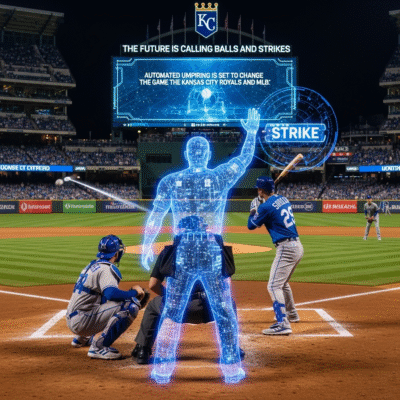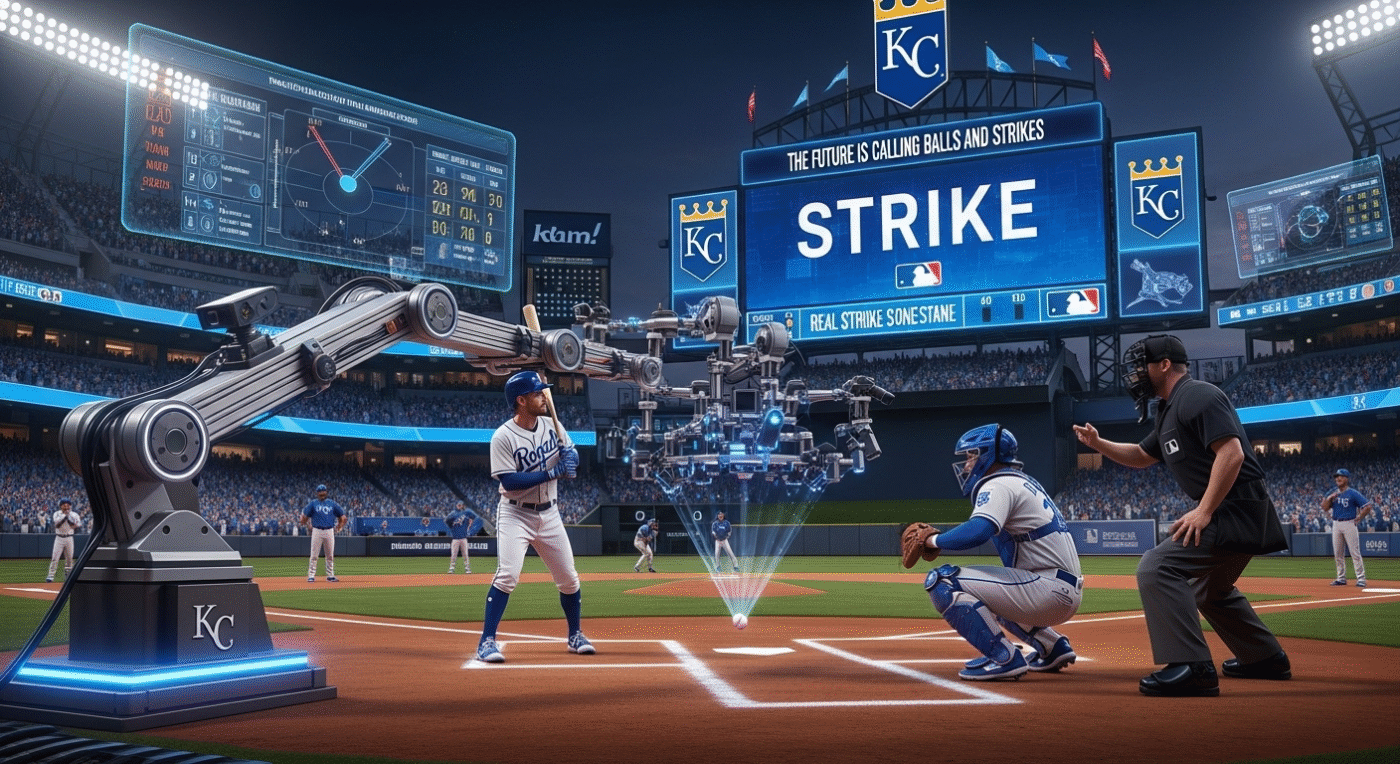Uncategorized
The Future is Calling Balls and Strikes: How Automated Umpiring is Set to Change the Game for the Kansas City Royals and MLB
The crack of the bat, the roar of the crowd, and the umpire’s decisive call – these are the foundational sounds of Major League Baseball. But what if one of those iconic sounds was soon to be augmented by the silent, unerring judgment of technology? The era of automated umpiring, long a topic of heated debate among baseball purists and modernists, is no longer a far-off hypothetical. It’s knocking on the door of Major League Baseball, and the Kansas City Royals could be one of the first teams to answer.
For years, the Automated Ball-Strike System (ABS), often referred to as “robot umpires,” has been meticulously tested and refined in the minor leagues, including at the home of the Omaha Storm Chasers, the Royals’ Triple-A affiliate.[1][2] This extensive trial period has provided a wealth of data and feedback, paving the way for its potential implementation at the highest level of the sport, possibly as soon as the 2026 season.[3][4][5]
The introduction of ABS promises a revolution in how the game is called, aiming to eliminate the human error that has at times cast a shadow over pivotal moments in baseball history. But this technological leap also raises fundamental questions about the soul of the game, the value of traditional skills, and how fans, players, and teams like the Royals will adapt to this new reality.
Two Paths to an Automated Strike Zone
Major League Baseball is currently exploring two distinct versions of the ABS technology. The first is a “full ABS” system, where every pitch is automatically called by the Hawk-Eye tracking system, with the home plate umpire receiving the call via an earpiece and relaying it.[6] The second, and seemingly more favored, is a “challenge system.” In this hybrid model, the human umpire remains the primary decision-maker for balls and strikes. However, each team is allotted a certain number of challenges per game, allowing them to contest a call they believe to be incorrect.[6][7]

This challenge system, which has been the focus of more recent testing in Triple-A and MLB spring training, seeks to strike a balance between technological accuracy and the human element that has been an integral part of baseball for over a century.[6][8] Minor league testing has indicated a preference for the challenge system among various stakeholders, as it retains a level of strategic nuance and the traditional role of the umpire, while still providing a mechanism to correct egregious errors.[6]
How the “Robot Umpire” Works: A Look Under the Hood
The technology powering the ABS system is a sophisticated network of high-speed cameras and sensors known as Hawk-Eye. This system, which has been a staple in professional tennis for years, tracks the baseball from the moment it leaves the pitcher’s hand until it crosses home plate.[7][9]
The system establishes a three-dimensional strike zone for each batter, with the top and bottom of the zone determined by a percentage of the player’s height.[4][10][11] This creates a personalized and consistent strike zone for every player, from the towering Aaron Judge to the more diminutive Jose Altuve.[10][12] When a pitch is thrown, the Hawk-Eye system determines with remarkable precision whether any part of the ball has passed through this virtual zone.[2]
In the challenge system, if a player, pitcher, or catcher disputes a call, they can signal for a review. The stadium’s video board then displays the Hawk-Eye rendering of the pitch’s trajectory, providing a definitive ruling in a matter of seconds.[6][9]
The Impact on the Kansas City Royals: A New Era for Pitchers and Catchers
The potential arrival of automated umpiring in Kansas City carries significant implications for the Royals’ roster, particularly for their pitching staff and catchers. One of the most debated aspects of ABS is its impact on the art of pitch framing – a catcher’s subtle ability to make a borderline pitch appear as a strike to the umpire.
For years, a catcher’s framing ability has been a highly valued, albeit often overlooked, defensive skill. An adept framing catcher can “steal” strikes for his pitchers, potentially altering the course of an at-bat, an inning, and even a game.
Historically, the Royals have had a complex relationship with this particular metric. Salvador Perez, a franchise icon and five-time Gold Glove winner, has, according to some advanced metrics, not always graded out as a strong pitch framer.[13][14] While his defensive prowess in other areas is undeniable, the introduction of an automated system that renders framing obsolete could, in theory, level the playing field for a catcher like Perez, whose other defensive skills would remain paramount. Conversely, a catcher like Freddy Fermin, who has shown significant defensive value, could see one of his key attributes diminished.[15]
For the Royals’ pitching staff, an automated strike zone could bring a new level of consistency. Pitchers would no longer have to adapt to the individual tendencies of different umpires. A strike would be a strike, regardless of who is behind the plate. This could lead to a greater emphasis on pitchers who can consistently command the strike zone with precision.
The Great Debate: Progress vs. Tradition
The prospect of automated umpiring has, unsurprisingly, ignited a passionate debate within the baseball community. Proponents argue that the primary goal should be to get every call correct. The implementation of ABS, they contend, would bring a new level of fairness and integrity to the game, eliminating the frustration and controversy that often accompany disputed ball and strike calls.[7] MLB Commissioner Rob Manfred has expressed his support for the system, highlighting its potential to enhance the game’s accuracy.[16]
However, many traditionalists lament the potential loss of the “human element.”[6] They argue that the occasional missed call is simply part of the fabric of the game, a source of drama and debate that adds to its appeal. There is a concern that a fully automated system could make the game feel sterile and less engaging. The strategic dance between a pitcher, a catcher, and an umpire – a cat-and-mouse game of trying to influence the strike zone – would be a thing of the past.[11]
Furthermore, the implementation of full ABS in the minor leagues has led to an increase in walks, which can slow down the pace of the game – a trend MLB has actively tried to combat with the introduction of the pitch clock.[6]
The Road to Implementation: What Lies Ahead
The path to bringing automated umpiring to Major League Baseball is a deliberate one. The decision will ultimately rest with the 11-person competition committee, which is composed of six ownership representatives, four player representatives, and one umpire.[3][5][17] While MLB has the authority to push through rule changes, there is a clear desire to ensure player buy-in.[17]
The extensive testing in the minor leagues and spring training has been crucial in gathering feedback and refining the system.[18] The use of the challenge system in this year’s All-Star Game was another significant step in familiarizing players and fans with the technology on a grand stage.[19]
While an official implementation date has not been set, all signs point to the ABS challenge system being a part of Major League Baseball in the near future, with 2026 being a frequently cited target.[4][5][20]
For fans of the Kansas City Royals and baseball enthusiasts everywhere, the coming seasons will be a fascinating period of transition. The introduction of automated umpiring represents one of the most significant rule changes in the sport’s long and storied history. It promises a future of greater accuracy and fairness, but it also challenges long-held traditions. As the technology continues to evolve and its implementation draws nearer, the boys in blue, along with the rest of the league, will be stepping into a new era of baseball – one where the final call may come not from the lungs of an umpire, but from the unblinking eye of a machine.
- kansascity.com
- kcur.org
- sportsnet.ca
- foxsports.com
- thescore.com
- mlb.com
- virginia.edu
- reddit.com
- robotics247.com
- nbcsports.com
- wikipedia.org
- livenowfox.com
- royalsreporter.com
- pitcherlist.com
- royalsreporter.com
- fastcompany.com
- cbssports.com
- youtube.com
- Current time information in Omaha, NE, US.
- si.com


